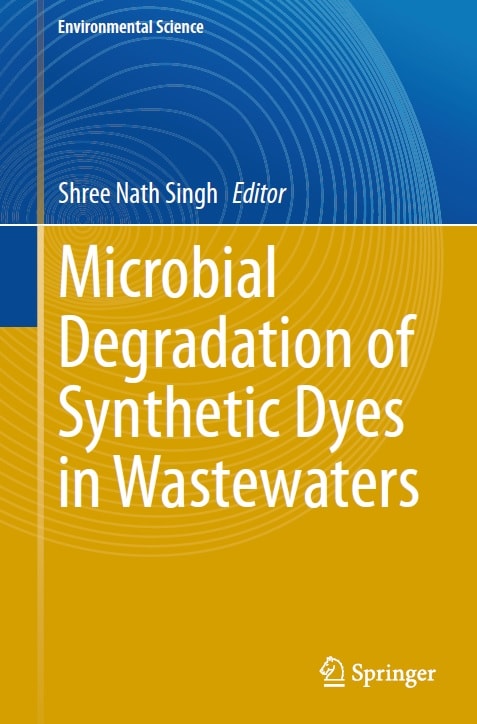
Contents
Mycoremediation of Synthetic Dyes: An Insight into
the Mechanism, Process Optimization and Reactor Design . . . . . . . . . 1
Prachi Kaushik and Anushree Malik
Bacterial Enzymes and Multi-enzymatic Systems
for Cleaning-up Dyes from the Environment. . . . . . . . . . . . . . . . . . . . 27
Sónia Mendes, Maria Paula Robalo and Lígia O. Martins
Bacterial Degradation of Azo Dye Containing Wastes . . . . . . . . . . . . . 57
Shailesh R. Dave, Tallika L. Patel and Devayani R. Tipre
Microbial Degradation of Basic Dyes in Wastewaters . . . . . . . . . . . . . 85
C. Ganesh Kumar and Poornima Mongolla
Reductive Decolorization of Azo Dye by Bacteria . . . . . . . . . . . . . . . . 111
Guangfei Liu, Jiti Zhou, Jing Wang, Xin Zhang,
Bin Dong and Ning Wang
Congo Red Decolorizing Bacteria from Paper Factory Effluent . . . . . . 135
Aileen C. Jalandoni-Buan, Anna Lynn A. Decena-Soliven,
Ernelea P. Cao, Virginia L. Barraquio and Wilfredo L. Barraquio
Bacterial Enzymes and Their Role in Decolorization
of Azo Dyes. . . . . . . . . . . . . . . . . . . . . . . . . . . . . . . . . . . . . . . . . . . . 149
Amar A. Telke, Avinash A. Kadam and Sanjay P. Govindwar
Microbial Decolorization of Triphenylmethane Dyes . . . . . . . . . . . . . . 169
Anna Jasińska, Katarzyna Paraszkiewicz,
Mirosława Słaba and Jerzy Długoński
Textile Dyes Degradation: A Microbial Approach
for Biodegradation of Pollutants. . . . . . . . . . . . . . . . . . . . . . . . . . . . . 187
Lokendra Singh and Ved Pal Singh
Microbe-Mediated Degradation of Synthetic Dyes
in Wastewater . . . . . . . . . . . . . . . . . . . . . . . . . . . . . . . . . . . . . . . . . . 205
Maulin P. Shah
Bacterial Degradation of Textile Dyes. . . . . . . . . . . . . . . . . . . . . . . . . 243
Kisan M. Kodam and Yogesh M. Kolekar
Application of Extremophilic Microorganisms
in Decolorization and Biodegradation of Textile Wastewater . . . . . . . . 267
M.A. Amoozegar, M. Mehrshad and H. Akhoondi
The Biodegradation of Azo Dyes by Actinobacteria. . . . . . . . . . . . . . . 297
Azeem Khalid and Shahid Mahmood
Degradation of Azo Dyes by White-Rot Fungi. . . . . . . . . . . . . . . . . . . 315
Susana Rodríguez-Couto
Degradation of Anthroquinone Dyes Stimulated by Fungi . . . . . . . . . . 333
S.N. Singh, Shweta Mishra and Nitanshi Jauhari
Index . . . . . . . . . . . . . . . . . . . . . . . . . . . . . . . . . . . . . . . . . . . . . . . . 357
Preface
Unlike natural dyes which are derived from plants, vegetables, and some minerals, synthetic dyes are manufactured by chemical processes and are commonly used for dying and printing in a wide range of industries. They are originally derived from coal tar derivatives, but are now synthesized from benzene and its derivatives. Synthetic dyes are usually named after the chemical structure of their particular chromophore group. The first synthetic dye, mauve, was discovered way back in 1956 by W.H. Perkin when he attempted to synthesize quinine.
Now, different synthetic dyes are produced, such as acid dyes, azoic dyes, basic dyes, chrome dyes, diazo dyes, direct dyes, disperse dyes, reactive dyes, sulfur dyes, and vat dyes. These dyes are widely used in different industries for dyeing cloth, paper, food, wood, etc. Among these chemical dyes, azo dyes are the most commonly used in dyeing units. There are more than 10,000 dyes as of now and their production has already exceeded 735 metric tons globally. Since synthetic dyes are cheaper, brighter, faster, and easier to apply to the fabric, they have
changed the entire scenario worldwide.
On the other hand, dyeing industries discharge an enormous amount of synthetic dyes in wastewaters which are very toxic to both animals and plants. In order to remove synthetic dyes from wastewaters, adsorption on various sorbents and chemical decomposition by oxidation and photo-degradation are widely used. However, microbial degradation or decolorization, employing activated sludge, pure cultures and microbial consortia, degradative enzymes, etc., has been found self-driven, cost-effective, and also eco-friendly.
Therefore, I endeavored to compile the latest state-of-art on the microbial degradation of synthetic dyes in wastewaters coming from dyeing units in an edited volume which will serve as a ready reckoner to scientists, environmentalists, policy makers, teachers, students, industrialists, NGOs, and others concerned.
In this attempt, I would like to profusely thank all the contributors for their prompt response and active participation by contributing review articles on different aspects of microbial degradation of synthetic dyes. Besides, I also acknowledge the research scholars associated with me, Ms. Shweta Mishra, Ms. Nitanshi Jauhari, Mrs. Babita Kumari, and Ms. Divyata Maurya (trainee) for their academic and technical support. Untiring service, provided by Mr. Dilip Chakraborty in preparing the manuscript meticulously, is also deeply acknowledged.
Lastly, I would also like to thank my family members: Mrs. Manorama Singh (wife), Ragini (daughter), and her kids Antra and Avantika, and Pritish (son) for their inspiration, endurance, and moral support to me in this endeavor.
